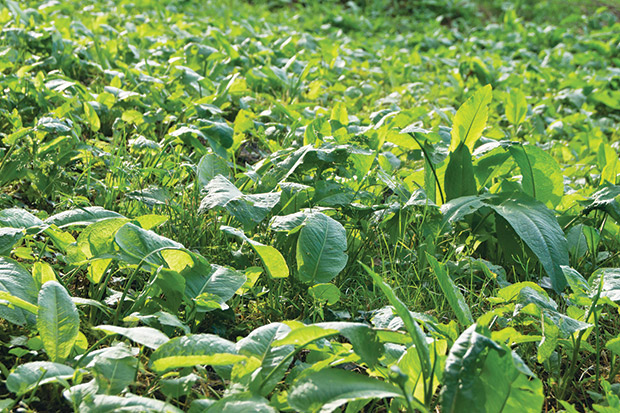Why your block needs some dock (it’s not the weed you think it is)

Research shows a small dock population can do animals good.
Words: Nadene Hall
Broad-leafed and curly dock (Rumex sp.) aren’t the weeds you think they are.
Research by Dr Charles Merfield of the Biological Husbandry Unit (BHU) in Christchurch into non-chemical management of dock shows it can be a useful plant to have in pasture.
Large dock populations are a problem, but a small dock population can do your livestock some good.
• Broad-leaved and curly dock are palatable to livestock, with higher potassium, zinc, magnesium and tannin levels than grass, helping to prevent bloat.
• Deer like dock best. Sheep and goats prefer young foliage, but goats will also eat the woody flower spikes. Young shoots of curly dock are particularly nutritious for cattle, but cattle will eat both types at all stages if hungry. Horses won’t eat it.
• Dock is the main food source for green dock beetles (Gastrophysa viridula), and part of the diet of other ‘good’ seed-feeding beetles.
6 TIPS TO CONTROLLING DOCK PATCHES
• The better your pasture management, the less dock you will have. This includes a healthy soil with good structure, good drainage, diverse, multi-species pasture plants, a rotational grazing plan, and minimal soil compaction.
• Rotational grazing, where stock eats out an area of pasture each day, is the best grazing method for dock control. It gives grasses a longer recovery time, improving root size. More leafy growth shades soil, preventing dock seeds from germinating.
• Soil compaction in wet seasons, even from lighter stock such as sheep, damages soil structure, giving dock a big advantage; grasses find it more difficult to grow, but dock thrives thanks to its long taproot.
• Dock loves high potassium soil and will out-grow grass; keep potassium levels at optimum or below to stunt its growth.
• Dock spreads by seed. Cutting or grazing dock, especially as it begins to flower, can reduce seed viability by up to 90 percent. Cutting a flower stem will encourage the plant to flower again, so it’s important to cut or graze it at the right to control regrowth.
• Dock regenerates from a crown in the same way as rhubarb. If you want to dig it out, you need to cut the root below the crown, about 5-10cm deep. If soil is wet, and you leave the cut crown sitting on top of the soil, it may regrow. When it’s hot and dry, it will die off.
Source: Research by the BHU Future Farming Centre
Love this story? Subscribe now!
 This article first appeared in NZ Lifestyle Block Magazine.
This article first appeared in NZ Lifestyle Block Magazine.
